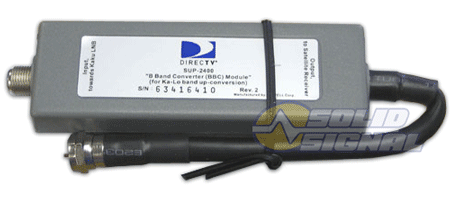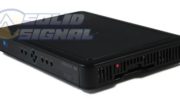The B-Band Converter was an essential part of every DIRECTV HD system in the mid-2000s. These little pigtails shipped with every HD receiver… you even got two with every DVR. Today they’re hard to come by… everywhere except SolidSignal.com!
What is a B-Band converter?
It’s a device that’s designed to let DIRECTV receivers pull in programs from DIRECTV’s HD satellites. It’s an odd little piece of engineering that was never really intended to be a permanent solution.
There are two different frequencies that are used in DIRECTV satellite TV. The most common is known as the Ku-band. That’s the frequency range from 12-18GHz that’s used for satellite broadcasting in most of the world. However, DIRECTV’s HD satellites don’t use that band. DIRECTV has exclusive use of the Ka-band frequencies from 26.5-40GHz. No one else in the US uses these frequencies for broadcasting, giving DIRECTV a lot of room for all the channels they want.
There’s only one problem…
…well ok more than one problem.. The truth is that it’s amazing that satellite TV works at all. The super-high broadcast frequencies work well for long-distance, low-power transmissions but it would take super-expensive cables to carry them from the dish to the receiver. So, the dish uses a device called a “block downconverter” to translate the super-high Ku-band frequencies to what’s called the L-band (950-2150MHz) and the even super-higher Ka-band frequencies to what’s called the B-band (250-750MHz.) This means they can travel on the same wire used for other TV services, which is relatively cheap.
OK, real quick…
here’s why the bands have funny names. The letters A-Z were used to denote broadcast frequencies, first by the US Military and then by NATO. Ka means “slightly above K” and Ku means “slightly below K.”
Satellite TV on the L band
Originally, the L-band was chosen for satellite TV because most cables could carry it and it was out of the way of traditional UHF and VHF programming which broadcast from 54-890MHz. That way, the same cable could carry TV and satellite at the same time. Later on DIRECTV sort of stopped caring as much about that and when they needed a frequency range for the new HD satellites they picked one right in the middle of the TV broadcast band.
So in order to tune the original satellite TV signal as well as the new HD signals, you would need a tuner that could go from 250 to 2150 MHz. This proved to be a really expensive thing and while DIRECTV did have two receivers that did this, they were way too costly. DIRECTV’s engineers settled on a different idea, which was to translate the B-band signals into the L band at the last minute when needed. They used a converter, which of course they called a B-Band converter (see what I did there?) When the receiver requests a signal from the B-band, the converters change it to the L-band. It’s actually cheaper than making a tuner that can do it all, surprisingly.
Not a perfect solution
Of course, this meant that you had to hang these things off every receiver and that wasn’t popular. It’s not that DIRECTV didn’t care, but they had something even more amazing in their pockets: SWM technology. SWM technology eliminates all this B-band, L-Band, etc. nonsense and allows for eight different signals to travel on the same wire, allowing for a single-wire connection to up to eight different devices hung off the same line. SWM technology was developed because people didn’t want to have all this extra wiring when compared to a cable TV setup. It’s cheaper to put in and it’s a cleaner solution as well. And… it doesn’t require B-band converters because all the frequency changes take place in the SWM module itself.
SWM technology came out in 2009 and since then the days of the B-Band Converter have been numbered. Most folks don’t even know what they are or what they do (of course you know … now) but if you’re still running an older DIRECTV system you know that you still need them. They were never designed to work for a decade, and they do wear out. That’s why SolidSignal.com is going to keep offering B-Band Converters until we can’t get them anymore. Our purchasing agents search worldwide for old stocks of converters. They’re not made in large quantities anymore. But, long as we can get them, we’ll offer them to you.
Today, only the very small number of people who don’t use SWM technology will need these converters. While that number continues to drop, it’s still a fairly large group. And, we’re here for them.
Another weird thing
What’s weird is that there’s another whole cult growing up around the humble B-band converter. Apparently the ham radio community uses them to extend the life of certain older radios that can not tune the frequencies used today. It’s just a happy coincidence that the B-Band converter also does this task for them, and that for the better part of a decade, it’s been fairly easy to get.





